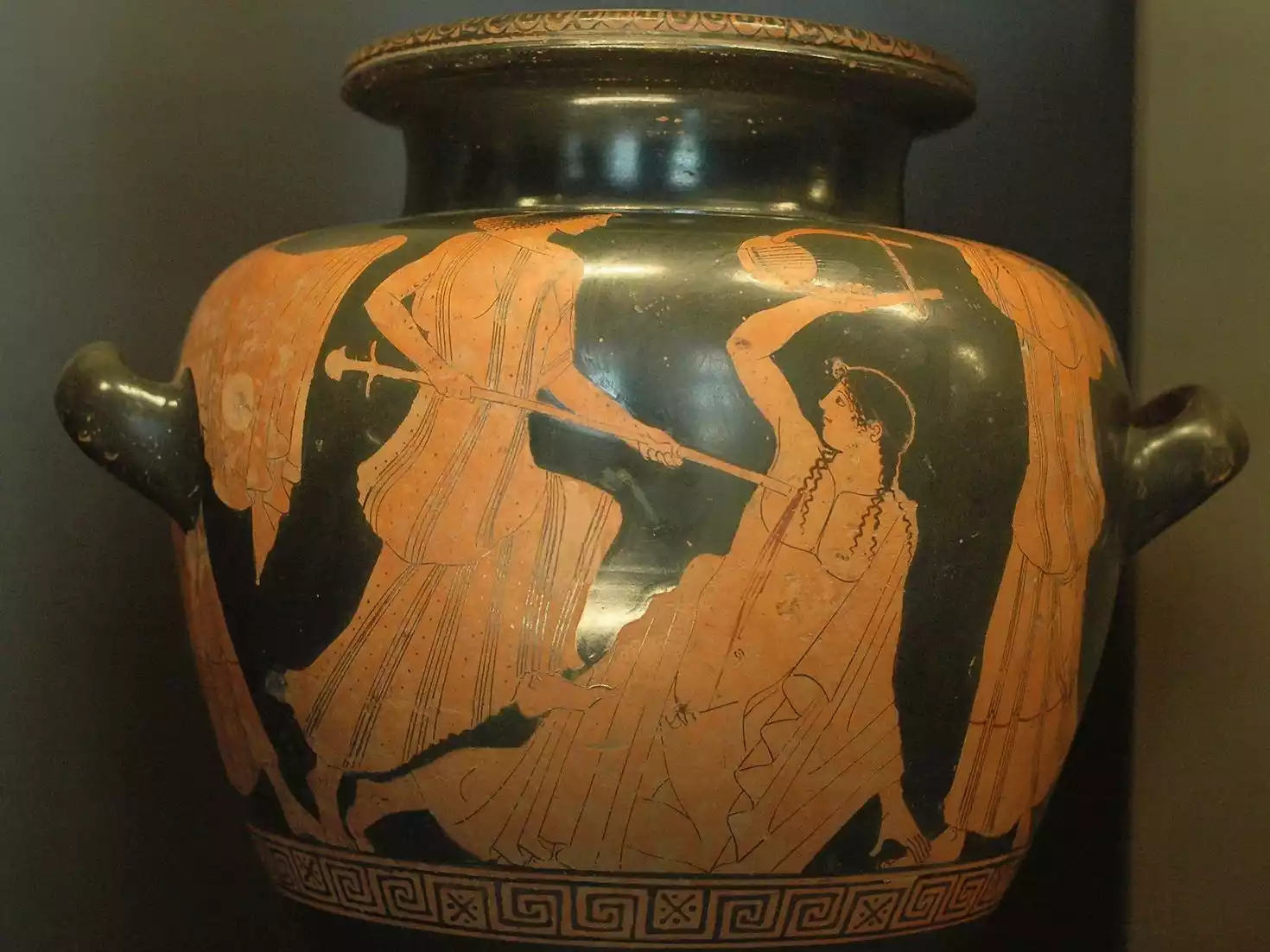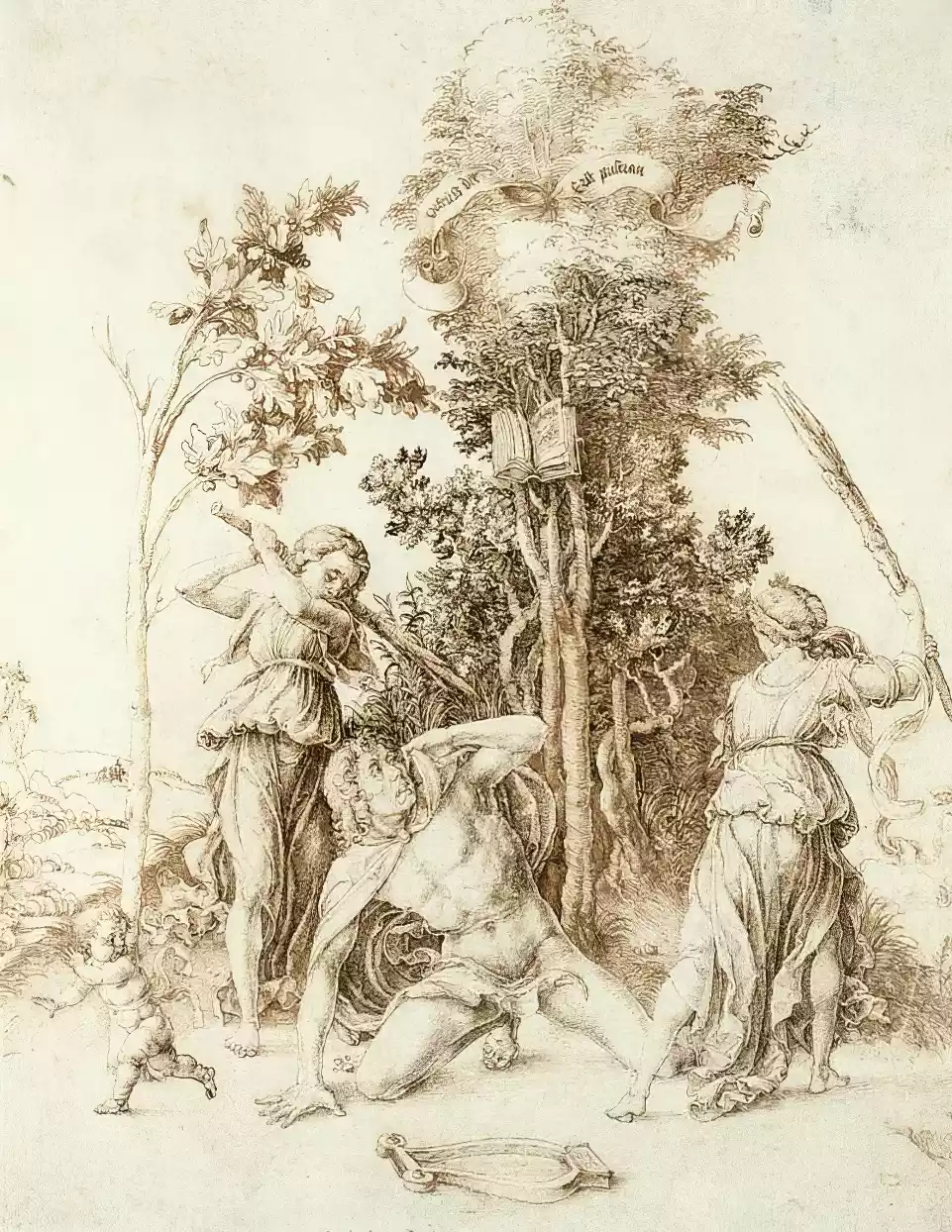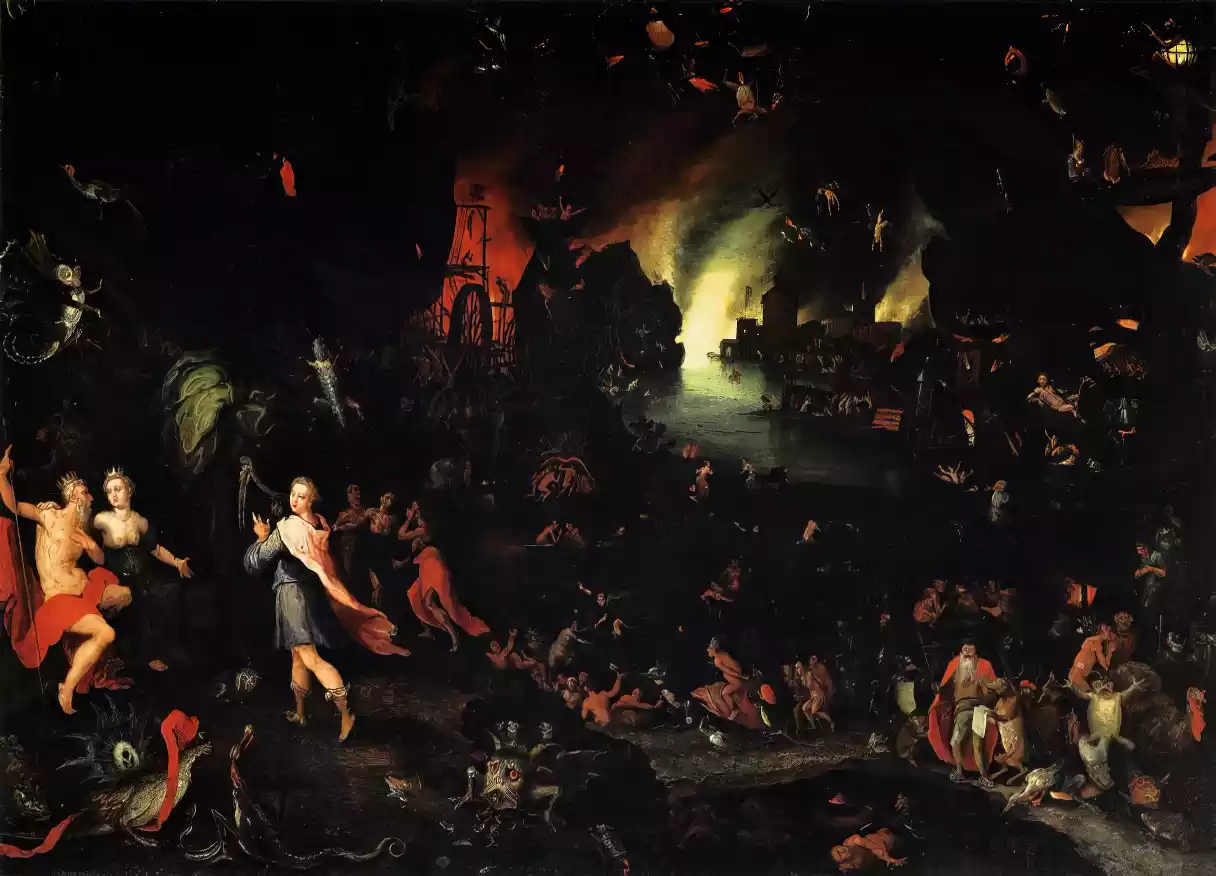
The death of Orpheus. Attic red-figure stamnos by Hermonax, ca. 470 BC. Related to the Orphic Mysteries. Louvre Museum (G 416).
In the rich world of ancient Greek religion, beyond the worship of the Olympian gods, there were the so-called “mysteries,” special cultic practices that promised initiates a deeper knowledge and, often, a better fate after death. Among these mystery cults, the Orphic Mysteries hold a special place, a set of beliefs and rituals that are inextricably linked to the legendary figure of Orpheus. Orpheus, the son of the Muse Calliope and, according to one version, of the god Apollo, was the mythical musician and poet who enchanted gods, humans, and all of nature with his lyre, capable even of moving the chthonic deities of the Underworld.
The Orphic Mysteries differ from other cults as they introduced a distinct theology and cosmogony, with their own myths about the creation of the world and the origin of gods and humans. The core of their teaching was the belief in the immortality of the soul, its fall into the material world due to an ancestral sin (linked to the myth of Dionysus Zagreus and the Titans), and the need for purification and liberation through a specific way of life (the so-called “Orphic life”) and secret rituals. These ideas had a significant impact on the philosophy and religious thought of the ancient Greeks, offering an alternative perspective on life, death, and the universe, with the Orphic teachings being discussed alongside esoteric texts (Dimopoulos). The allure of these mysteries lies precisely in the promise of revealing sacred truths, accessible only to the initiated, and in the hope for a more favorable afterlife. (It may be worth looking for more about the ‘Orphic Life’).
The Myth of Orpheus: The Musician Who Enchanted the Underworld
The figure of Orpheus is central to understanding the eponymous mysteries. Son of the Muse Calliope and, according to some traditions, of the god Apollo or the Thracian king Oeagrus, Orpheus was considered the greatest musician and poet of antiquity. His music, played with the lyre (a gift from Apollo), was so enchanting that it could tame wild beasts, move rocks and trees, and even charm the gods. His fame led him to participate in the Argonautic expedition, where his singing intervened heroically in critical moments, covering, for example, the dangerous song of the Sirens.
The most famous story associated with Orpheus is his tragic love for the nymph Eurydice. Shortly after their wedding, Eurydice was fatally bitten by a snake. Devastated, Orpheus made the bold decision to descend to Hades to bring her back. With his music, he managed to move Charon, Cerberus, and ultimately Pluto and Persephone, the rulers of the Underworld. They agreed to allow him to take Eurydice back to the world of the living, on one condition: he must not turn to look at her until they both reached the light of the sun. As they ascended, just before the exit, anxiety and doubt overtook Orpheus. He turned to see if his beloved was following him, only to see her lost forever back into the shadows. This moment, where Orpheus found himself beside her just as Eurydice was disappearing, captures the absolute tragedy of the myth (Fry). After the definitive loss of Eurydice, Orpheus wandered despondently, avoiding the company of other women. His death is also surrounded by myth, with the most prevalent version saying that he was torn apart by frenzied Maenads (worshippers of Dionysus) in Thrace, either because he scorned them or because he did not honor Dionysus.

Orpheus among the Thracians. Attic red-figure bell-krater, ca. 440 BC.
Key Teachings of Orphism: Soul, Purification, and Immortality
The Orphic Mysteries offered a distinct system of beliefs, focused on the fate of the human soul. At the core of Orphic teaching was the idea of dualism: the perception that man consists of two elements, a divine and immortal one (the soul) and a mortal and material one (the body). The soul, of divine origin, was considered trapped or “imprisoned” within the body (the famous phrase “body is a tomb”), as a result of an ancestral sin.
This primordial sin is linked to the central Orphic myth of Dionysus Zagreus. According to this myth, the Titans, out of envy, dismembered and ate the young Dionysus, son of Zeus. Zeus, enraged, struck them down. From the ashes of the Titans, which also contained the remnants of the divine Dionysus, humanity was created. Thus, humans carry within them a dual nature: the titanic, material, and sinful, and the Dionysian, divine, and immortal. The goal of Orphic initiation and the “Orphic life” was the purification from the titanic element and the liberation of the divine soul.
This liberation could not be achieved in a single life. Orphism introduced into Greek thought, or at least widely disseminated, the idea of reincarnation (or palingenesis), the successive embodiment of the soul in different bodies until complete purification was achieved. To expedite this process, the Orphics followed a strict way of life that included moral rules, ritual purity, and, above all, abstention from the consumption of living beings (vegetarianism), as they believed that animals could also host souls in the process of reincarnation. Through initiation rituals and adherence to these rules, the believer hoped to break the cycle of births and return the soul to its divine state (Kakridis).
The violent murder of Orpheus by the Maenads, in a drawing by Albrecht Dürer (1494). This myth is a central element of the tradition of the Orphic Mysteries. Kunsthalle, Hamburg.
The Orphic Cosmogony: A Different Narrative of Creation
Beyond the teachings about the soul, Orphism also developed its own distinct cosmogony and theogony, that is, its own narratives about the creation of the universe and the genesis of the gods. These narratives, preserved mainly through hymns and references from later authors (such as the Neoplatonists), present a picture quite different from the more well-known version of Hesiod’s Theogony.
At the beginning of all things, according to many Orphic sources, it was not Chaos, but the eternal Time (often winged and with animal heads) and his companion, Necessity. From their union, or from the primordial Night, the cosmic Silver Egg emerged. From this egg was born the first creative deity, Phanes (meaning “he who reveals” or “shines”), a hermaphroditic, winged entity with golden wings, often identified with Love, the Primordial, or Metis. Phanes contained within him the seeds of all beings and was considered the creator of heaven and earth.
The continuation of the Orphic theogony includes the succession of divine generations (Night, Heaven, Cronus), but with a critical intervention: Zeus, to gain absolute dominion, swallows Phanes, thus incorporating his creative power. Then, Zeus recreates the world and becomes the new beginning of all things. In this context, the birth of Dionysus-Zagreus from Zeus and Persephone is also included, who was destined to become the new ruler of the universe, before his tragic dismemberment by the Titans. This complex and symbolic cosmogony emphasized the divine origin of the world and the soul, and provided the mythological background for the Orphic teachings on purification and liberation.

Thracian woman, possibly from a scene of the death of Orpheus (a theme related to the Orphic Mysteries). Attic red-figure kylix, ca. 480–470 BC. Attributed to the Brygos Painter. Metropolitan Museum of Art.
The Rituals of the Orphic Mysteries: Initiation and Sacred Texts
As their name suggests, the Orphic Mysteries included secret initiation rituals, the details of which remain largely unknown, as initiates were bound by an oath of silence. However, from various sources and archaeological findings, we can form a picture of the nature of these rituals. Emphasis was placed on purity, both moral and physical. Prospective initiates likely underwent periods of fasting, abstinence, and purifying baths.
Central to Orphic worship were the sacred texts, attributed to Orpheus himself. These included hymns, theogonical and cosmogonical poems (such as the so-called “Orphic Hymns”), and texts that described Orpheus’s descent to Hades or provided instructions for the soul’s journey after death. Understanding these texts, with their mysterious verses, was considered a privilege of the initiated and required special interpretation, accessible only after the performance of the secret rituals (Detienne). Some of these texts, such as the Derveni Papyrus (one of the oldest European “books”), offer a rare glimpse into the allegorical interpretation of Orphic poems by the followers of the cult themselves.
Particularly significant are the findings of thin gold leaves (lamellae) that were placed in the graves of certain believers in areas such as Lower Italy, Thessaly, and Crete. These leaves bore engraved instructions to the soul of the deceased on how to navigate the Underworld, how to avoid dangers, and how to declare its Orphic identity to the chthonic deities (“I am a child of the Earth and the starry Sky, but my lineage is celestial”), thus ensuring a favorable afterlife. These findings provide tangible evidence of the belief in the immortality of the soul and the importance of Orphic teachings for guiding the soul after death. (Archaeology continues to uncover evidence of ancient mystery cults).
The Enduring Echoes of Orphic Mysteries Across Civilizations
The Profound Impact of Orphism Beyond Ancient Greece
It’s crucial to acknowledge that while Orphism never solidified into a structured, centralized religious institution resembling the Olympian pantheon, complete with a formal priesthood and grand, dedicated temples, the current of its philosophical ideas and mystical practices radiated outward, leaving an indelible mark on the landscape of Greek intellectual thought and extending its influence far beyond. Within the expansive narrative of spiritual exploration, the Orphic emphasis on the soul’s inherent immortality, the imperative of a morally grounded life, the necessity of ritual purification, and the alluring prospect of liberation from the cyclical nature of incarnations resonated powerfully with a broad spectrum of philosophers, theologians, and religious thinkers across ancient societies, much like the deep and abiding influence of certain philosophies have found a place in the intellectual heritage of the USA. The reach of these concepts underscores the universal human fascination with questions of existence that transcend temporal boundaries.
The enigmatic figure of Pythagoras, along with his devoted followers, the Pythagoreans, seemed to share a substantial number of core tenets with the Orphic tradition. Commonalities such as the doctrine of reincarnation, the adherence to an ascetic lifestyle, and the practice of vegetarianism highlight the interconnectedness of these intellectual spheres. The intricate relationship between Orphism and Pythagoreanism has long been a subject of scholarly debate and academic scrutiny, yet the undeniable interaction between these two schools of thought serves as a testament to their mutual influence. An even more profound impact can be traced in the philosophical contributions of Plato, who seamlessly integrated Orphic concepts, or ideas that were circulating within Orphic circles, into some of his most seminal dialogues, including “Phaedo,” “Gorgias,” and “The Republic.” Plato’s articulation of the soul’s immortality, its metaphorical imprisonment within the physical body, the concept of recollection, and the indispensable need for philosophical purification all bear the unmistakable imprint of the Orphic tradition.
The far-reaching influence of Orphic ideas extended into other mystery cults of antiquity, each retaining its own distinct ritualistic character and unique mythological framework. The enduring figure of Orpheus, the legendary musician imbued with profound wisdom and a tragic fate, continued to captivate the imaginations of poets, artists, and philosophers throughout the expansive epochs of the Roman Empire, the medieval period, and the Renaissance, leaving a spiritual and aesthetic inheritance that stretches into our contemporary era. The persistent human quest for spiritual liberation, the steadfast belief in a latent, divine spark residing within the human soul, and the unwavering hope for transcendence over the constraints of mortal existence, all central themes within the Orphic Mysteries, maintain a timeless relevance, continuing to stimulate and engage human thought in its ongoing exploration of life’s deepest enigmas. Therefore, the legacy of Orphism transcends the mere documentation of archaeological artifacts or philosophical references; it perseveres as a living testament to the enduring allure of the great, perennial questions surrounding existence, the soul, and the enigma of the afterlife.
Depiction of Orpheus enchanting Hades (1594), by Jan Brueghel the Elder. The descent into the Underworld is a central element of the myth behind the Orphic Mysteries. Oil on copper, Palazzo Pitti, Florence.
Different Interpretations & Critical Assessment
The study of the Orphic Mysteries is not without challenges and differing approaches. Scholars such as W.K.C. Guthrie emphasized the unity and continuity of the Orphic tradition, viewing Orphism as a distinct religious movement with specific roots and development. Others, like M.L. West, adopted a more critical stance, questioning the existence of a single “Orphism” during the archaic and classical periods and seeing more a collection of heterogeneous texts and ideas later attributed to Orpheus. Marcel Detienne focused more on analyzing the myths and rituals as cultural phenomena, examining the role of writing and interpretation in the Orphic tradition. The precise dating of Orphic texts and the historicity of Orpheus himself remain open issues, fueling ongoing academic discussion.
Conclusion
The Orphic Mysteries represent a fascinating and somewhat enigmatic chapter of ancient Greek religiosity. Offering a different perspective on the world, humanity, and the fate of the soul, they were distinguished by their deep philosophical implications and emphasis on individual spiritual quest and purification. The belief in immortality, the idea of reincarnation, the myth of Dionysus Zagreus, and the ascetic “Orphic life” composed a belief system that influenced significant thinkers and left its mark on the course of Western thought. Although many aspects of their rituals remain hidden behind the veil of mystery, the allure of Orpheus and the promise of his Mysteries for knowledge and liberation continue to attract us, reminding us of the eternal human quest for meaning beyond the limits of mortal existence.
Frequently Asked Questions
What exactly were the Orphic Mysteries in Greek Mythology?
The Orphic Mysteries were a set of secret religious beliefs and rituals of ancient Greece, attributed to the mythical Orpheus. They focused on the idea of the immortality of the soul, its fall into the body, reincarnation, and the need for purification through a specific way of life and initiation, aiming for the ultimate liberation of the soul. Their understanding fits into the broader context of Greek Mythology and religion.
What is the relationship of Orpheus with the Orphic Mysteries?
Orpheus, the legendary musician and poet of Greek Mythology, was considered the founder and first teacher of the Orphic Mysteries. Many of the sacred texts, hymns, and teachings of the cult were attributed to him. His descent to Hades and the knowledge he supposedly gained there made him an ideal figure to convey secret truths about life and death.
Did all ancient Greeks believe in the Orphic Mysteries?
No, the Orphic Mysteries were not part of the dominant, public religion of the city-states, such as the worship of the Olympian gods. They constituted a distinct, mystery cult that appealed to those seeking a more personal and profound relationship with the divine and a hope for a better afterlife. Participation was voluntary and required initiation, differing from the common cultic practices of Greek Mythology.
What is the “Orphic life”?
The “Orphic life” refers to the specific way of life that initiates in the Orphic Mysteries were called to follow. It primarily included moral and ritual purity, but the most characteristic element was abstention from the consumption of meat (vegetarianism) and, according to some sources, from certain other foods like beans. This ascetic lifestyle was considered necessary for the purification of the soul.
Are there any proofs of the existence of the Orphic Mysteries?
Yes, beyond the references of ancient authors (philosophers, historians), there are also archaeological findings related to the Orphic Mysteries. The most significant are the gold leaves (amulets) found in graves with instructions for the soul, as well as the Derveni Papyrus, which contains an Orphic poem and its allegorical interpretation. These findings confirm basic aspects of the Orphic beliefs of Greek Mythology.
Bibliography
- Detienne, Marcel. The Writing of Orpheus: Greek Myth in Cultural Context. Johns Hopkins University Press, 2002.
- Dimopoulos, Evangelos. “ORPHIC”. Plato, vol. 37, 1985, p. 71.
- Fry, Stephen. Heroes. Patakis Publications, 2023.
- Kakridis, Ioannis Th., ed. Greek Mythology: The Gods, Volume 1. Athens Publishing, 1986, p. 304.



